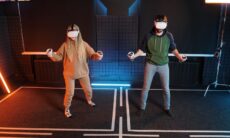Virtual screens may boost cardiac ablation procedures
A new study has suggested that augmented reality could play a greater role in cardiac ablation when supported by virtual screens that can be arranged to suit the clinician’s preferences. The findings, published in the Journal of Interventional Cardiac Electrophysiology, explored how additional digital displays may improve usability during such procedures.
Researchers examined the potential of a feature currently in development for the CommandEP mixed reality system, produced by Sentiar in St. Louis. CommandEP already provides real-time three-dimensional digital images through augmented reality. The proposed upgrade introduces up to five virtual screens, enabling clinicians to design their own digital workspace. The evaluation was carried out on animal models to assess its effectiveness in practice.
During traditional electrophysiology studies, multiple physical monitors are often needed to display data sources such as electrograms, intracardiac echocardiography, fluoroscopy, and three-dimensional electroanatomic mapping. These varied inputs can make it challenging to manage information in real time. The new system allows these discrete data streams to be connected to a single access point, which wirelessly transmits them to a head-mounted display. From there, the virtual screen module makes it possible to create a customised spatial arrangement of chosen screens directly within the user’s field of view.
Feedback gathered from ablation procedures carried out with this technology indicated that usability levels were high. Test participants consistently reported that the virtual screens delivered practical and relevant data during studies. The ability to configure layouts according to individual workflow needs was seen as a notable advantage. Importantly, there were no concerns about the clarity of images when tested with different data inputs, which reinforced the potential of the system for routine use.
Clinicians also observed that having access to this type of innovation could significantly influence their practice. The flexibility to adapt information displays in real time was highlighted as a valuable enhancement, suggesting that adoption of such tools could streamline complex procedures. While the study group acknowledged the limited scale of the research, with tests conducted only on animal models, the results were nonetheless seen as encouraging.
It was disclosed that two of the study’s co-authors are representatives of Sentiar. However, the authors stressed that the research itself was carried out independently and outside any commercial or financial arrangements that might present conflicts of interest.
Further investigations will be required to assess the technology’s effect on procedure duration and patient outcomes. Larger clinical studies will be necessary before it can be fully integrated into routine practice. The authors also noted that other medical technology companies are developing similar solutions, suggesting a growing trend in the industry toward expanded use of augmented reality in interventional cardiology.
The findings point to a future in which augmented reality, enhanced by versatile virtual screens, could provide clinicians with a more effective way of managing the wealth of information required during cardiac ablation. While still at an early stage, the ability to tailor digital environments to individual preferences may represent a meaningful step towards more efficient and adaptable clinical workflows.










